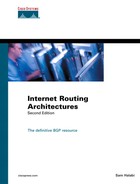Route Reflector
Route reflector configuration may now be specified on a per-AF basis, providing a considerable amount of flexibility over the old "centralized" method. This section discusses both old and new styles of configuring route reflection.
Old Style
With the old style, route reflector (RR) client properties were specified globally, and the configuration applied to all AFs negotiated with its clients. The RR knew that it had to reflect routes to and from clients by specifying route-reflector-client for a particular neighbor or IBGP peer group. The following is an example in which the IBGP peer 1.1.1.1 is made a route reflector client for both unicast and multicast IPv4 prefixes:
router bgp 109 neighbor 1.1.1.1 remote-as 109 nlri unicast multicast neighbor 1.1.1.1 route-reflector-client
AF Style
The AF style of configuring router reflects the fact that a neighbor or peer group is a route reflector client is AF-dependent and is configured in AF mode. In other words, just because a peer is a route reflector client in IPv4 unicast mode does not automatically make it an RR client in IPv4 multicast mode. It must now be specified by explicitly configuring the client in IPv4 multicast AF mode. Thus, the preceding configuration that made 1.1.1.1 a client for both unicast and multicast would now be expressed as follows:
router bgp 109 neighbor 1.1.1.1 remote-as 109 neighbor 1.1.1.1 route-reflector-client ! address-family ipv4 multicast neighbor 1.1.1.1 activate neighbor 1.1.1.1 route-reflector-client
The new mode gives the operator the flexibility to make a router the route reflector for only certain AFs. As such, the route reflector topologies for different AFs can vary.
